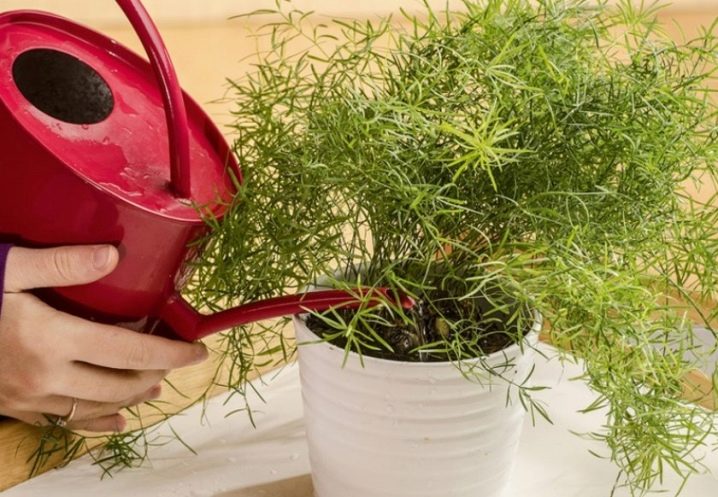Asparagus pinnate: description and care at home

Feathery asparagus has long and firmly won the hearts of domestic flower growers. This plant can decorate any interior and create an indescribable atmosphere of comfort in the house. According to the teachings of Feng Shui, this houseplant with unusual leaves has the ability to cleanse the energy of the house from negative emotions, helps its owners to cope with prolonged depression, stress and strong feelings.

Specifications
The feathery asparagus is a perennial shrub with rather slender, curly stems. In the presence of all kinds of trellises and supports, this flower can grow straight up, or it can fall in cascading waterfalls or hang down in liana-like lashes. The plant belongs to the Asparagus family, the shoots visually resemble bird feathers, which is why the flower got its name. In the people it is more often called "cobweb" or "the finest asparagus".






The role of the leaves is played by cladonia - needle-like shoots collected in large bunches near stems up to 1.5 m long. All stems originate from the same growth point, which creates the feeling of fluffy foliage. The leaves of asparagus themselves grow from the very base of the cladonia in the form of underdeveloped brown scales.

The root system is branched, characterized by the presence of tubers, the plant can accumulate water in them and hold it for a long time in case of unfavorable external factors.
In indoor conditions, when creating a comfortable living environment, it can bloom. As a rule, this occurs at 5-9 years of age. The flowers are milky white, small, star-shaped with a pronounced pleasant smell. The fruits are small dark blue berries, inside of which seeds are formed.

In natural conditions, feathery asparagus grows in the tropical and subtropical climate of Africa, which is why the plant prefers high humidity and warm air. Asparagus can very quickly adapt to new living conditions and the room where it is kept. It is rather unpretentious in care, so even the most inexperienced florist can cope with its cultivation.

Asparagus pinnate is one of the most decorative members of its family. Its fluffy and light shoots create the feeling of an airy cloud of green color, therefore they will add lightness and sophistication to any room, and will place spectacular accents in interiors of any style.

Reproduction methods
At home, decorative feathery asparagus can be propagated vegetatively, usually using one of 3 methods.
Dividing the bush
This method creates stressful conditions for the plant, since it involves the destruction of the integrity of the roots, this method is optimal only if the bush has grown too much. The flower is removed from the container and the roots are divided into several parts, usually from 2 to 4, after which the damaged areas are treated with crushed activated carbon and transplanted into new pots with fresh nutrient substrate. After transplanting, the plant must be moistened and placed on a bright window on the east or west side.

Within a month, it is better not to make any manipulations with the flower, except for watering, since with this method of reproduction, asparagus is sick for a long time, and any change in external factors can aggravate the situation.
Seeds
This is a very long and laborious way. Most often, breeders resort to it to develop new varieties of plants, but if you want to replenish the collection of your green pets, it is quite possible to purchase seed material in any specialized store and start growing. The purchased seeds are soaked in water for a couple of days, after which they are kept in a weak solution of potassium permanganate for half an hour - in this way they are stratified and disinfected, only after this procedure they become suitable for planting in the ground.

The material is spread over the surface of the soil mixture, slightly deepening, sprinkled with earth and covered with glass or plastic wrap. Thus, greenhouse conditions are created that promote early germination. After about a month, all the shoots appear, then the greenhouse can be removed, and when the shoots reach a length of 10-15 cm, they are transplanted to a permanent place. The germination of seedlings can be significantly accelerated if each seed is carefully pierced with a thin needle.


Cuttings
This is the simplest and most affordable way for ordinary growers. In this case, it is necessary to cut off the adult shoots and place them in a vessel with water for rooting. Before roots appear, it is advisable to cover the vessel with a bag or a cut plastic bottle to maintain the required moisture level. To prevent decay, the water should be changed every 5-7 days; it will be useful to add a little activated carbon or methylene blue solution. As a rule, rooting takes about two months, after which the cutting can be transplanted into the ground.

Transfer
Asparagus belongs to the fast-growing representatives of asparagus, and this applies to both the ground part and the rhizome, therefore, regular replanting is an indispensable condition for the full growth and development of the plant. If the procedure is neglected, then the flower will not actively grow and retain its exotic appearance. It is better to replant young plants annually; for adult flowers, you can renew the soil less often - every 3-4 years with regular renewal of the top layer of the earth.

Usually, the transplant is carried out in early March, as soon as the plant comes out of dormancy, however, if the bush has grown too much, this can pose a danger to the feathery asparagus, then it can be transplanted at any other time.
In most cases, the procedure is carried out by the transshipment method - this is the only way to keep the roots intact, while with each subsequent transplant, the container must be taken wider than the previous one, by about 1.5-2 cm.

To minimize the damage caused to the flower while moving to a new place of residence, it is necessary to adhere to a certain order of replanting. First, you should prepare a new container, be sure to form a drainage layer of expanded clay or large pebbles. The plant is carefully removed from the old pot, all diseased parts are cut off. If during the procedure the roots were damaged, then you need to cut off the broken parts with a sterile knife and sprinkle with an antiseptic.

The earthen lump together with the roots is transferred into a new container and all the vacant cavities are sprinkled with fresh substrate. Be sure to leave a little space to the edge of the container when doing this, as the rapidly growing roots will lift the soil over time. The land is watered and left in a warm place to adapt. Keep in mind that asparagus is not particularly picky about soil mixtures, but it still develops best in a nutrient soil, slightly acidified, with good water and air permeability. It is advisable to use ready-made store-bought soil for ferns.

Home care
Feathery asparagus is an unpretentious plant that grows and develops well in a room environment, so it is often bought for landscaping schools, clubs, office buildings, libraries and other public places. This representative of the tropical flora has the ability to quickly adapt to the environment and, with basic care, grows very quickly, while maintaining its exclusively decorative appearance.

Plant care is carried out in a standard mode, maintaining the desired level of humidity, illumination and temperature background, watering and periodic feeding.
Lighting
It should be noted that the feathery asparagus is the only representative of the species that does not like bright sunlight, preferring a light shade. It is best to place your pet on east or west windows with curtains; special stands or shelves in the back of the room are also suitable. Provided there is a sufficient amount of scattered light, as well as under intense artificial lighting, asparagus grows and develops even on the northern side. At the same time, in the cold months, the plant requires additional lighting with fluorescent lamps of the daytime spectrum. If the daylight hours are less than 10 hours, then the shoots will begin to stretch.

Temperature regime
During the active growing season, asparagus feels comfortable at normal room temperature of 20-24 degrees, with abundant watering, the plant easily tolerates an excess of the temperature background up to 30 degrees and above, but the maximum minimum is limited to 15 degrees. If the air in the room is colder, then the flower will simply die, and rather quickly. Asparagus does not tolerate drafts, so when choosing a site for placing your green pet, you should choose one where there is no movement of cold air masses.

Humidity
It is very important to organize watering of asparagus in such a way as to prevent overdrying of the earthen coma or waterlogging of the earth. In both cases, yellowing and shedding of leaves occurs and, as a result, a complete loss of the decorative effect of the plant. Watering the asparagus as needed, usually in the summer it is done 2-4 times a week, depending on the temperature, and in the winter the number of irrigations is reduced.

By the way, cirrus asparagus needs calcium to maintain normal life, it is found in excess in ordinary tap water, therefore there is no need to defend it before irrigation.
The humidity in the room should be slightly higher than the standard room humidity. To do this, you need to spray the asparagus with a spray bottle every day, and also turn on a humidifier. A good way to maintain a comfortable habitat is to place sphagnum moss in a pallet or turn on an indoor fountain near the flower.
Top dressing
In the spring and summer period, asparagus needs fertilization. To do this, it is best to use ready-made store preparations for ferns - they are bred in accordance with the instructions and applied immediately after watering twice a month. In the resting phase, fertilizers are not needed for asparagus; in the summer, from time to time, you can replace complex agents with nitrogen, but here it is important not to overdo it, since an excess of nitrogen leads to excessive stretching of the flower.

Diseases and pests
Asparagus often becomes the subject of attack by pests, more often than others it is affected by aphids, as well as scale insects, spider mites and thrips. It is important to keep in mind that this flower reacts very badly to all kinds of chemicals, therefore, the use of fungicidal compositions in the fight against parasites is not justified - if the leaves turn yellow and sick, you should examine the flower and, if necessary, cut off the damaged areas. After that, it is worth treating the entire green mass with a solution of laundry soap, and after 3-4 hours give your pet a warm shower.




If these measures did not lead to the desired result, then you should completely cut off all the leaves, transplant the flower into a new pot and wait for the young growth to appear.
If the rules for caring for a flower are not followed, serious problems often arise - diseases of a fungal and bacterial nature. More often than others, asparagus encounters gray mold, which affects all green parts of the plant when exposed to high humidity and waterlogged soil. If you pay attention in time to the fact that the plant has begun to wither, then it can still be saved - for this, the roots are completely cleaned of soil, cut off all damaged areas, sprinkle with coal and transplant the plant into a new pot filled with fresh soil.

For information on how to maintain and care for pinnate asparagus, see the video below.



























The comment was sent successfully.